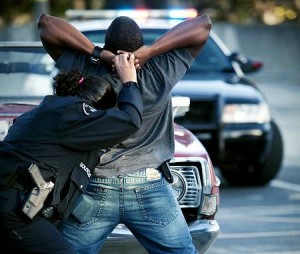(ThyBlackMan.com) A prominent issue in the New York press is the New York Police Department’s “Stop-and-Frisk” policy. This policy was originally designed to reduce crime in New York City by targeting suspects likely to be involved in criminal activity. The media’s coverage of the controversy it has generated takes different forms depending upon the newspaper one happens to read. . .
I came across several articles pertaining to “Stop-and-Frisk” in The New York Amsterdam News over the last month. In “Riding While Black” by Kelsie Bonaparte in the January 26 issue, we are quickly apprised of the sentiments of the Black and the Latino community. It is strongly felt that the Fourth Amendment rights – the right of people to be secure in their persons, houses, papers, and effects, against unreasonable searches and seizures – have been “used and abused in an unconstitutional manner by the NYPD.” Bonaparte sheds light on the practice of “Stop-and-Frisk” while riding in livery cabs which is the subject of a federal lawsuit filed by the New York Civil Liberties Union (NYCLU). NYCLU does not challenge police stops of livery cabs to ensure the safety of drivers, but they do object to the questioning and frisking of passengers when there is no suspicion of wrongdoing.
In an opinion piece in The Amsterdam News the following week by Nick Malinowski titled “Stop and Frisk: A shameful policy that feeds oppression,” we are reminded of the far reaching repercussions “Stop-and-Frisk” has on the Black and Latino communities. Malinowski, a social worker and activist with the Stop Mass Incarceration Network, drives home the bleak reality most  Blacks and Latinos face when subjected to such “racial oppression and exploitation that this country was built upon and which continues to thrive.” News outlets such as WNYC have issued reports pertaining to the documented arrests by the NYPD, citing most as illegal. Reports also reveal common police practices, such as unconstitutional searches, like those described by Ms. Bonaparte above, as well as evidence planting in many cases. Malinowski describes those caught up in this system as victims of improper arrest by the NYPD. Tens of thousands of individuals, predominantly people of color, swept up into the prison system as a result of “stop-and-frisk,” Malinowski contends, will inevitably become jobless, homeless, and disenfranchised. As a result, the NYPD has successfully criminalized young people of color, “a useful cover-up that has been marinated and refreshed by the media.”
Blacks and Latinos face when subjected to such “racial oppression and exploitation that this country was built upon and which continues to thrive.” News outlets such as WNYC have issued reports pertaining to the documented arrests by the NYPD, citing most as illegal. Reports also reveal common police practices, such as unconstitutional searches, like those described by Ms. Bonaparte above, as well as evidence planting in many cases. Malinowski describes those caught up in this system as victims of improper arrest by the NYPD. Tens of thousands of individuals, predominantly people of color, swept up into the prison system as a result of “stop-and-frisk,” Malinowski contends, will inevitably become jobless, homeless, and disenfranchised. As a result, the NYPD has successfully criminalized young people of color, “a useful cover-up that has been marinated and refreshed by the media.”
Malinowski opines that had there been a nationwide mandate for the aggressive policing of minor drug crimes, “no-knock warrants would be more prevalent on college campuses than they are in the ‘hood.’” Instead, police increasingly use the pretext of possible drug activity to stop, frisk, harass, and arrest thousands of individuals who face greater repercussions if they dare to assert their constitutional rights to live free from police harassment, humiliation and violence. An officer can physically abuse a person, but if that person even attempts to protect themself, they face loss of employment, housing, voting rights, and a slew of other civil rights. It is apparent that these practices provoke a public distrust of the NYPD in communities fraught with over-policing, and contributes to the fracture of community cohesion, which experts agree is the true antidote to criminal behavior.
Michael Goodwin of The New York Post has quite a different stance on the topic of “Stop-and-Frisk.” In his article published on Feb. 26, 2012, “Taking Swings at NYPD,” Goodwin points out that crime is near historic lows and there have been no successful terror attacks in 10 years, so naturally, there is a growing “gang of loons, ideologues and dupes lining up to take its whacks at the NYPD” like a piñata. Goodwin attributes the results of certain anti-terror and anti-crime policies to “hard, smart, and dangerous” police work, not “fairy dust and magic.” Mayor Bloomberg has taken to calling police officers and firefighters “first preventers” instead of first responders. It is considered one of the great advances of modern government, that policing can do more than just catch criminals after the fact, but can actually save lives with a “strict legal framework of restraint.” Police Commissioner Ray Kelly assures us that the NYPD will continue doing what they’ve been doing. “Our policies are very carefully vetted and according to the law and the Constitution.”
Reading Goodwin’s article from The Post after reading those from The Amsterdam News, one has to wonder which Constitution Ray Kelly is referring to. Mr. Goodwin, in his article for The Post, makes bold claims but does not cite any statistical evidence in support thereof.
The New York Times uses plenty of statistics in its article on this topic by Kate Taylor, “Police Street Stops Hit a Record, Rising 14%,” Feb. 15, 2012. Taylor takes a neutral stance, mainly listing numerical statistics and quoting various elected officials, letting the numbers speak for themselves. She cites data gathered by the New York Civil Liberties Union (NYCLU). In 2011, almost 700,000 people were stopped by police officers, the highest number since data collection started in 2002. This is a 14% spike over 2010 and a roughly 600% increase from Bloomberg’s first year as Mayor, a decade ago. The number that stands out above all is the percentage of those stopped that were Black or Latino, a staggering 87%, while only 9% were white – quite a stark contrast. The record statistics prompted civil rights leaders and elected officials to protest in front of City Hall. Scott M. Stringer, Manhattan Borough President, echoed the sentiments of Malinowski of The Amsterdam News when he was quoted in a statement affirming “It’s racial profiling, it’s racism, and it’s having dire consequences in our city.” Stringer accused Mayor Bloomberg of failing to take responsibility for the NYPD’s use of the “Stop-and-Frisk” policy, and challenged the mayor to stop hiding on an issue that is so compelling.
A spokesman for Police Commissioner Kelly, Paul J. Browne, defended the policy, stating, “Stops save lives.” Browne contends that in the decade before Bloomberg took office, there were over 11,000 murders recorded in NYC, compared to only 5,430 murders in the decade since Bloomberg took office, a “remarkable achievement” which saved 5,628 lives thanks to “proactive policing strategies that included stops.” Donna Lieberman of the NYCLU called the numbers “a scandal” and dismissed the NYPD’s argument that the practice made the public safer, citing 1 in 650 street stops, or one-fifteenth of 1 percent, quite a miniscule number, had led to an arrest for possession of a firearm.
John Doyle and Rocco Parascandola of The New York Daily News also published a story on this topic on Feb. 15, 2012, “Stop-&-frisks soar to record.” Similar to The Times article, The Daily News article adopted a neutral stance, citing statistics and quoting elected officials and members of the general public. Donna Lieberman of The NYCLU is again quoted as saying, “it is little wonder that to many, policing in New York City is a tale of two cities.” Manhattan Borough President Stringer, who is white, says that the issue does not resonate with white New Yorkers but should be a concern to all races. Dominick Sanchez of Harlem, who is black, says, “If you’re not white, you’re going to get stopped.” Sanchez was stopped recently and questioned about robberies on his block. He said, “I wanted to talk back to them, but they threaten you.” Sanchez’s quote brings me back to Malinowski’s article in The Amsterdam News and his discussion of the denial of basic constitutional rights by the NYPD.
While the articles covering “Stop-and-Frisk” in both The New York Times and The Daily News cite numerical facts and quote both sides of the argument, I find them both disturbingly brief and inadequate. A civil rights issue of this magnitude should be given much more robust coverage, which we do find in The Amsterdam News. Earlier I cited Bonaparte’s article as well as Malinowski’s opinion piece. In the February 23 – February 29 issue, Cyril Josh Barker addresses the matter once again in his article, “Stop-and-frisk: Will it ever end?” Barker cites the statistics we now know so well and quotes Al Vann, Brooklyn City Councilman, “Rather than reflexively defending the practice by citing declining crime statistics, Bloomberg and the NYPD should be thoughtfully reviewing how the use of this practice is deteriorating the relationship between citizens and law enforcement, marginalizing entire communities and violating the civil rights of thousands of New Yorkers.” Further, the Center for Constitutional Rights (CCR) confirmed “this kind of heavy-handed policing promotes mistrust and fear of police officers in communities of color. Rather than servicing those communities, police end up occupying them.”
In conclusion, it is apparent that The Amsterdam News has taken a passionate stance on the issue of “Stop-and-Frisk” thereby setting the table for open dialogue and vigorous debate. The Amsterdam News’ stance, I believe, is healthy because an open channel of communication can lead to cooperation and cohesion not only amongst the Black and the Latino communitis, but potentially amongst all other races as well. In contrast, papers like The Daily News and The New York Times have made it a point to cover the debate briefly, simply citing statistics and quoting both sides of the fray, but choosing not to speak out on the issue. The New York Post has taken the side of the NYPD and Mayor Bloomberg clearly advocating for the NYPD, but it fails to support its claims with numerical evidence. The Post, Daily News, and The Times have a much larger audience than The Amsterdam News, which comes out weekly and is mainly read in the Black community. They should make it a point to bring the issue of “stop-and-frisk” to the forefront and help foster a greater sense of awareness. Racism in 2012, sadly, is alive and well, and if the media continues to cast a blind on the issue, the current state of affairs will only fester and worsen. And none can foresee what the end result will be. . .
Staff Writer; Saeed Ahmed

















Leave a Reply